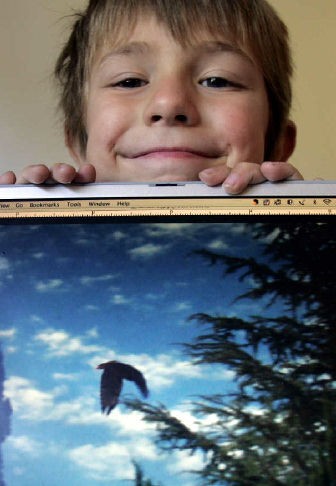
November 6, 2006
What if this story is about a large flying cryptid? This youngster did a better job than many adults do when they see something large and unknown, flying off into the sunset.

Monday, Nov 06, 2006
Small fry captures rare glimpse of straying big bird
By Bob Pool
Los Angeles Times

Gabriel Gottfried, 5, shows the digital photo he took of a condor launching from a pine tree near his Los Angeles home.
LOS ANGELES – Like any good bird-lover, Gabriel Gottfried knew what to do when he spied the huge creature perched on a tree branch outside his Topanga Canyon home.
He grabbed his camera to document what experts say might be the first California condor to fly the canyon’s skies in more than 100 years.
His photo of the elusive bird taking wing was remarkable enough. But perhaps not as remarkable as the fact that Gabriel is 5 years old.
“I’m five-and-a-half!” corrects the pint-sized photographer whose sharp eye and quick shutter finger are being saluted by conservationists throughout the rustic residential canyon.
Wildlife experts who are hailing Gabriel’s photo say it’s conceivable that a condor was taking temporary refuge from a huge wildfire that ravaged parts of the Los Padres National Forest in September and October.
The forest’s Sespe Condor Sanctuary and adjoining Hopper Mountain National Wildlife Refuge is where captive-bred condors have been released in an attempt to reintroduce them to the wilds. Topanga Canyon is within easy soaring range of the condor preserves.
Federal wildlife officials say the condors dispersed when the fire approached their sanctuary areas. All have since returned, Denise Stockton, a spokeswoman for the U.S. Fish and Wildlife Service, said last week.
Stockton and others have studied Gabriel’s photo in hopes of identifying the bird. But the silhouetted image is too dark to show identifying features or the numbers attached to all condors in the breeding program, she said. &
ldquo;It’s amazing,” Stockton said of the child’s handiwork.
The photograph depicts the giant bird – its head hunkered down and its powerful wings flexing – as it launches itself from a pine tree across the street from Gabriel’s house.
Gabriel photographed the creature about a month ago after coming home from kindergarten. When his nanny, Mayra Flores, commented on the big bird in the tree, Gabriel dashed to a hallway shelf where he keeps the digital point-and-shoot camera that his mother gave him. Just as he aimed it through his bedroom window, the bird took off.
“I’d never seen that kind of bird before,” Gabriel says.
Living on the upper-most northern ridge of the canyon, the boy is familiar with its winged inhabitants. Red-tailed hawks are common. A great horned owl lives in one neighbor’s tree. Once, his parents, Mary Benjamin and Rick Gottfried, had to rescue a woodpecker from inside the family dwelling.
Demonstrating how he aimed the camera through the bedroom window, Gabriel talks of his photographic technique.
“I tried to take it on the tree, but it moved. I followed it by accident and got it in midair. My dad helped me get the picture out of the camera and into the printer.”
Benjamin, a documentary film producer, purchased the inexpensive Kodak digital camera for Gabriel after the expense of supplying him with disposable film cameras to take snapshots grew too high.
Gottfried, a counselor and family therapist, admits to being flabbergasted when he downloaded the image of the hulking creature.
“I didn’t know what it was. I’ve lived in the canyon 20 years and I’ve never seen a condor here,” he said.
Others knew immediately. When kindergarten classmate Jamie Mazur’s mother dropped Jamie off at Gabriel’s house the next day for a play date, it only took one look to convince her.
Jamie’s mother, Susan Clark, runs Topanga Animal Rescue and has studied condors.
“The wingspan of a condor can be up to 10 feet. I went out and looked at the trees shown in the photograph. It had a huge wingspan – nothing else could have had a wingspan like that,” she said.
Experts say the last condor was probably seen in Topanga’s skies around 1898.
Kris Ohlenkamp, president of the San Fernando Valley Audubon Society, said it’s doubtful the birds will again become permanent residents of Topanga Canyon.
“I think there would be too much disturbance for them here to actually breed,” he said.
About Loren Coleman
Loren Coleman is one of the world’s leading cryptozoologists, some say “the” leading living cryptozoologist. Certainly, he is acknowledged as the current living American researcher and writer who has most popularized cryptozoology in the late 20th and early 21st centuries.
Starting his fieldwork and investigations in 1960, after traveling and trekking extensively in pursuit of cryptozoological mysteries, Coleman began writing to share his experiences in 1969. An honorary member of Ivan T. Sanderson’s Society for the Investigation of the Unexplained in the 1970s, Coleman has been bestowed with similar honorary memberships of the North Idaho College Cryptozoology Club in 1983, and in subsequent years, that of the British Columbia Scientific Cryptozoology Club, CryptoSafari International, and other international organizations. He was also a Life Member and Benefactor of the International Society of Cryptozoology (now-defunct).
Loren Coleman’s daily blog, as a member of the Cryptomundo Team, served as an ongoing avenue of communication for the ever-growing body of cryptozoo news from 2005 through 2013. He returned as an infrequent contributor beginning Halloween week of 2015.
Coleman is the founder in 2003, and current director of the International Cryptozoology Museum in Portland, Maine.
Filed under Breaking News, CryptoZoo News, Cryptozoology, Evidence, Eyewitness Accounts, Forensic Science, Thunderbirds